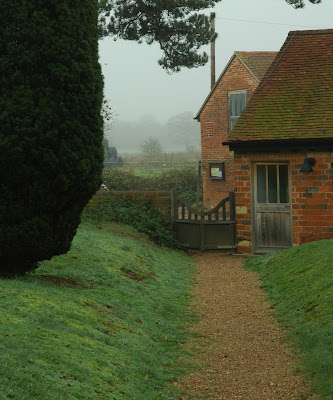Detours
Yesterday on my way back home from running errands, I noticed a small sign for Wisley Church, and thought I'd check it out. It was out of my way, but I've been feeling a bit cooped up lately and thought exploration would be good for me. So glad I followed that instinct.
After following a progressively narrowing and winding road for a bit, I came upon an old Norman church, which I learned was originally founded in the 1100s.
For those of you whose early English history is a bit rusty, the Norman invasion of England, headed by William the Conqueror in 1066, changed the face of England in many ways, culturally, governmentally, linguistically, even in terms of the physical landscape (and, interestingly, it laid the foundation for hundreds of years of English-French conflict). (Battle of Hastings, as depicted in the Bayeux Tapestry) As occupiers, the Normans were notoriously brutal. They sacked villages, confiscated land, and built imposing castles that served as humiliating reminders of Anglo-Saxon defeat. In fact, they busied themselves building lots of structures, including many rustic little country churches that still stand today.
(Battle of Hastings, as depicted in the Bayeux Tapestry) As occupiers, the Normans were notoriously brutal. They sacked villages, confiscated land, and built imposing castles that served as humiliating reminders of Anglo-Saxon defeat. In fact, they busied themselves building lots of structures, including many rustic little country churches that still stand today.
Wisley church is petite and quiet. There wasn't much sunlight yesterday and so the interior was dim and shadowy. I sat for a little while, soaking in the quiet and the blueish, melancholy light. I love old stonework; like other artifacts--cooking utensils, tools, furniture, jewelry, textiles, weaponry--it is an intimate link to people long gone that, for me, fills in so many details of who they were, how they lived, what they were like. It was difficult to get any really good shots of the interior given how dark it was. 
And the very pretty path leading from the road:
As I was leaving I met the Vicar, who seemed to eye me cautiously at first (I later learned the church was robbed last week) but lit up when he learned of my interest in Norman architecture. He directed me to another old church a few miles down the road, St. Nicholas.
This one was built in 1140, and unlike many churches which have Norman foundations but whose structures have been augmented over the centuries, St. Nicholas's structure is completely Norman. Caretakers also uncovered 12th century frescoes which, much like the original stonework, I find really touching.
They are apparently done in red ochre and depict the Passion and local pilgrims preparing to set sail for a pilgrimage to Spain.
Finally, here's a peaceful scene from the St. Nicholas graveyard:




1 comment:
Awesome. If it was Jersey, there'd be a Bed, Bath & Beyond in that last pic by now.
Post a Comment